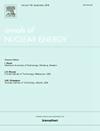Subchannel analysis of post-dryout flow and heat transfer in a tight-lattice fuel assembly
IF 1.9
3区 工程技术
Q1 NUCLEAR SCIENCE & TECHNOLOGY
引用次数: 0
Abstract
The tight-lattice fuel assembly is a key research area in the design of the high-performance water reactor, of which the thermal–hydraulic characteristics are significantly different from those used in the conventional pressurized water reactor because of its small pitch-to-diameter ratio. Under loss-of-flow accidents, the dryout and post-dryout heat transfer characteristics in the fuel assembly directly impact its safety. However, the relevant studies are limited, restricting the core design and safety analyzation. In this paper, a subchannel code suitable for post-dryout flow and heat transfer in the tight-lattice fuel assembly is developed based on MATRA program by introducing submodels specialized for various flow and heat transfer regimes. By comparing with experimental data of rod bundles, it is confirmed that the developed subchannel code can accurately predict the dry-out location and the heat transfer of mist flow after dryout in the tight lattice fuel assembly. Subsequently, the subchannel code is utilized to analyze the post-dryout heat transfer behavior in the tight lattice fuel assembly. The results indicate that the hydraulic diameter of subchannel significantly influences the flow field distribution. The corner subchannel with a small hydraulic diameter has the lowest flow rate, and thus the vapor void fraction and quality vary fastest along the axial direction. Though the central subchannel with the largest hydraulic diameter has the highest mass flux, but due to the large heating area, the vapor void fraction and quality still increase relatively high. The transverse flow between different subchannels follows the trend from the corner subchannel to the side subchannel, and then to the central subchannel. Due to the high mass flux and high quality in the corresponding subchannel, the dryout occurs earliest on the center rod, resulting in the largest wall temperature. Meanwhile, the spacer grids show stronger effects on post-dryout heat transfer enhancement in each subchannel. The research conclusions could provide reference to the thermal–hydraulic design of the tight-lattice fuel assembly.
紧晶格燃料组件干后流动和传热的子通道分析
紧密点阵燃料组件是高性能水堆设计中的一个重点研究领域,由于其节径比小,其热水力特性与传统压水堆有明显不同。在失流事故中,燃料组件的干燥和干燥后传热特性直接影响其安全性。但相关研究有限,制约了堆芯设计和安全性分析。本文在MATRA程序的基础上,通过引入适合于各种流动和传热形式的子模型,开发了适合于紧栅燃料组件干后流动和传热的子通道代码。通过与棒束实验数据的比较,证实了所开发的子通道代码能够准确预测致密点阵燃料组件的干化位置和干化后雾流的换热情况。随后,利用子通道代码分析了紧密点阵燃料组件干后传热行为。结果表明,子通道的水力直径对流场分布有显著影响。水力直径小的转角子通道流量最小,沿轴向汽蚀率和汽蚀质量变化最快。水力直径最大的中央子通道虽然质量通量最高,但由于受热面积大,汽蚀率和质量仍增加较高。不同子通道之间的横向流动遵循从角子通道到边子通道,再到中心子通道的趋势。由于相应子通道的质量通量大、质量高,中心杆的干干发生最早,壁温最大。同时,间隔栅对各子通道干后换热的强化作用更强。研究结论可为紧密点阵燃料组件的热液设计提供参考。
本文章由计算机程序翻译,如有差异,请以英文原文为准。
求助全文
约1分钟内获得全文
求助全文
来源期刊

Annals of Nuclear Energy
工程技术-核科学技术
CiteScore
4.30
自引率
21.10%
发文量
632
审稿时长
7.3 months
期刊介绍:
Annals of Nuclear Energy provides an international medium for the communication of original research, ideas and developments in all areas of the field of nuclear energy science and technology. Its scope embraces nuclear fuel reserves, fuel cycles and cost, materials, processing, system and component technology (fission only), design and optimization, direct conversion of nuclear energy sources, environmental control, reactor physics, heat transfer and fluid dynamics, structural analysis, fuel management, future developments, nuclear fuel and safety, nuclear aerosol, neutron physics, computer technology (both software and hardware), risk assessment, radioactive waste disposal and reactor thermal hydraulics. Papers submitted to Annals need to demonstrate a clear link to nuclear power generation/nuclear engineering. Papers which deal with pure nuclear physics, pure health physics, imaging, or attenuation and shielding properties of concretes and various geological materials are not within the scope of the journal. Also, papers that deal with policy or economics are not within the scope of the journal.
 求助内容:
求助内容: 应助结果提醒方式:
应助结果提醒方式:


